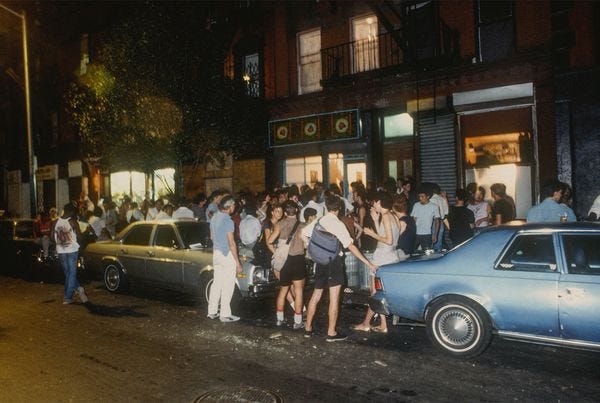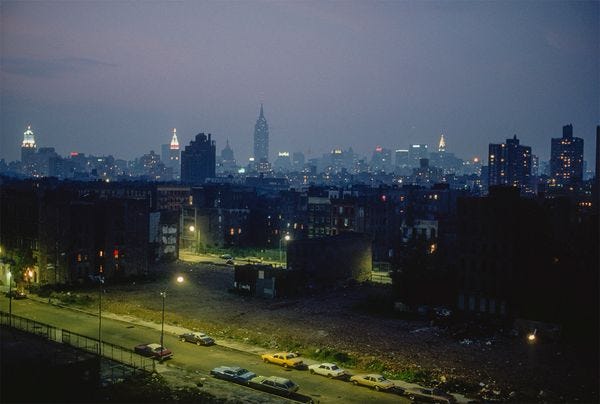the limbo lounge
“Okay. We’re starting.”
One place where Luis and I showed our work early on was called The Limbo Lounge. The Limbo was started in the early 1980s and run by the three Limbos — Michael, Victor, and Jeanette. I do not believe Limbo was their given name. Like so many people back then, they decided to choose. I later found out they weren’t even siblings.
Almost immediately, the Limbo became a place where artists in the East Village would come to hang out. It was on 10th Street, with no signage out front, so it was never invaded by the tourists or the bridge-and-tunnel people. You went because you knew other artists would be there, and at least one of the three Limbo siblings — each of whom was a natural attraction in their own right. Kind, efficient, smart. Good-looking. One would make so many connections, you kept coming back. They sold beer and alcohol and little sandwiches, and set up booths inside, although none of this was entirely legal.
Shortly after opening, the Limbos embarked upon an exhibition strategy. They decided to show a different artist each week. The artist was left pretty much to his or her own devices, to do whatever he or she wanted. There would, of course, be an opening party. Everyone could come, and everyone did.
It was a small place, but absolutely crawling with kindred spirits. At these openings, there were always people outside on the steps, not really wanting to enter, or not being able to, because there wasn’t enough space. It was like rush hour on the subway. We were right off the park, so you could maybe catch a bird, or a squirrel, from time to time.
I believe just about any artist who declared him or herself such could get a show at the Limbo. For a young artist, this could be very useful. Usually, having had a show in New York would open doors in other cities across the country and around the world. “Oh, you show in New York — you must be a real artist.” That was the attitude. New York made one valid, unlike anywhere else. In the 1980s, New York was the center of everything. It was the cutting edge. Finance, fashion, art, etc. It attracted the best and the brightest, the bravest, the most peculiar and eccentric, the most talented people from all over all over. In all my years in New York, I met very few people who were actually from there. Most were pretty equally accumulated from across the entire face of the Earth. There were so many dialects, so many languages, but we could all understand each other easily. Our ears became used to these extreme dialects.
Soon the Limbo was at the center of the whole East Village gallery world, with thirty of forty galleries all popping up in a ten block radius. We were protected from the outside world, because for the mob — well, lets call them the mob — the East Village was considered to be very dangerous. There was shattered glass on the street, the landlords were not maintaining their buildings. The landlords wanted at least some presence, usually on the first floor, so they drove the prices down. $100 usually, for the ground floor, and also very cheap for the apartments up above, where young people would find unusual apartments, where they would live and work — usually illegally. Everything was rather shabby. No one seemed to care.
We wanted and needed a place to live, a place to work, a place to basically get on with life. It was a lifestyle that seemed to suit everyone there. It seemed everyone there was working all the time, and working from a high-octane energy derived from inspiration. Discipline was something else. The artists in the East Village didn’t really need to draw on discipline, since they were eager to work all day and all night running on the encouragement they got from the community, and the inspiration surrounding their work. “Go for it” people would say all the time. It was never, “are you sure?” Or, “hang on.” It was, “Why not?” As long as it doesn’t kill someone. Try not to burn anyone’s house down. We weren’t really bound by any strong sense of morality.
Anyway, after a few dozen galleries opened up, the media suddenly noticed. Then the braver of the art lovers and art buyers started to show. Usually in a limousine. With a driver. Unlike the galleries Uptown, where wine was served at openings, in the East Village, gallons of vodka would appear. The vodka was a major attraction, probably almost as big an attraction as the art itself. The excitement and enthusiasm around these openings was extremely intense and beautiful.
Of course, there were drugs. Quaaludes were big, smack, ecstacy, cocaine. Lots and lots of marijuana. Practically anything one could think of was sooner or later pushed in front of your face, in the most enticing fashion. I never bought drugs, but I did them when people put them in front of me. Some of the time. The only time I bought drugs was by mistake. A friend had called me from Brazil. He said he had discovered these amazing white shirts, with the most beautiful white buttons. They were priced at $100 each. So I said, “Wow. I want one.” A few weeks later, he was back in New York and he called me. I asked him if he could deliver my shirt. He came by and pulled out a little bag of Brazilian cocaine. I said, “I thought a bought a shirt.” He started giggling and said, “Oh, Russell, you’re so naive.” I saved it for my opening party at Hal Bromm.
Anyway. Everything was fresh. Everything was welcoming. That was the feeling I got, anyway. I don’t think I ever saw fights or arguments although I’m sure they happened occasionally.
The Lower East Side became such a lovely neighborhood for our sort of people. It could’ve never been planned. It grew very organically, tended by the people who arrived, loved by the people who arrived, and respected by the people who arrived. 1980 through 1985 was a period of constantly meeting new artists, looking at their work, showing your work, a party that never ended. Constant work. Constant celebration. There were no limits. For those five years it was about as close to heaven as one could get on this Earth.
“I’ll put on some 80s music. Do you like Donna Summers?”
“Can you turn that off?” Daisy said. “The audio quality would be really better.”
photos by Andreas Sterzing






